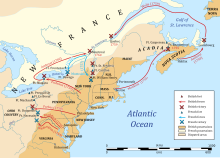 Global Information
Global InformationFrench and Indian War information
| French and Indian War | |||||||||
|---|---|---|---|---|---|---|---|---|---|
| Part of the Seven Years' War and the Sixty Years' War | |||||||||
 The war theater | |||||||||
| |||||||||
| Belligerents | |||||||||
|
| ||||||||
| Commanders and leaders | |||||||||
|
Killbuck Shingas Pontiac | ||||||||
| Strength | |||||||||
| 42,000 regulars and militia (peak strength, 1758)[1] | 10,000 regulars (troupes de la terre and troupes de la marine, peak strength, 1757)[2] | ||||||||
| Casualties and losses | |||||||||
| Unknown | ||||||||
The French and Indian War (1754–1763) was a theater of the Seven Years' War, which pitted the North American colonies of the British Empire against those of the French, each side being supported by various Native American tribes. At the start of the war, the French colonies had a population of roughly 60,000 settlers, compared with 2 million in the British colonies.[4] The outnumbered French particularly depended on their native allies.[5]
Two years into the war, in 1756, Great Britain declared war on France, beginning the worldwide Seven Years' War. Many view the French and Indian War as being merely the American theater of this conflict; however, in the United States the French and Indian War is viewed as a singular conflict which was not associated with any European war.[6] French Canadians call it the guerre de la Conquête ('War of the Conquest').[7][8]
The British colonists were supported at various times by the Iroquois, Catawba, and Cherokee tribes, and the French colonists were supported by Wabanaki Confederacy member tribes Abenaki and Mi'kmaq, and the Algonquin, Lenape, Ojibwa, Ottawa, Shawnee, and Wyandot (Huron) tribes.[9] Fighting took place primarily along the frontiers between New France and the British colonies, from the Province of Virginia in the south to Newfoundland in the north. It began with a dispute over control of the confluence of the Allegheny River and Monongahela River called the Forks of the Ohio, and the site of the French Fort Duquesne at the location that later became Pittsburgh, Pennsylvania. The dispute erupted into violence in the Battle of Jumonville Glen in May 1754, during which Virginia militiamen under the command of 22-year-old George Washington ambushed a French patrol.[10]
In 1755, six colonial governors met with General Edward Braddock, the newly arrived British Army commander, and planned a four-way attack on the French. None succeeded, and the main effort by Braddock proved a disaster; he lost the Battle of the Monongahela on July 9, 1755, and died a few days later. British operations failed in the frontier areas of the Province of Pennsylvania and the Province of New York during 1755–57 due to a combination of poor management, internal divisions, effective Canadian scouts, French regular forces, and Native warrior allies. In 1755, the British captured Fort Beauséjour on the border separating Nova Scotia from Acadia, and they ordered the expulsion of the Acadians (1755–64) soon afterwards. Orders for the deportation were given by Commander-in-Chief William Shirley without direction from Great Britain. The Acadians were expelled, both those captured in arms and those who had sworn the loyalty oath to the king. Natives likewise were driven off the land to make way for settlers from New England.[11]
The British Pitt government fell due to disastrous campaigns in 1757, including a failed expedition against Louisbourg and the Siege of Fort William Henry; this last was followed by the Natives torturing and massacring their colonial victims. William Pitt came to power and significantly increased British military resources in the colonies at a time when France was unwilling to risk large convoys to aid the limited forces that they had in New France, preferring to concentrate their forces against Prussia and its allies who were now engaged in the Seven Years' War in Europe. The conflict in Ohio ended in 1758 with the British–American victory in the Ohio Country. Between 1758 and 1760, the British military launched a campaign to capture French Canada. They succeeded in capturing territory in surrounding colonies and ultimately the city of Quebec (1759). The following year the British were victorious in the Montreal Campaign in which the French ceded Canada in accordance with the Treaty of Paris (1763).
France also ceded its territory east of the Mississippi to Great Britain, as well as French Louisiana west of the Mississippi River to its ally Spain in compensation for Spain's loss to Britain of Spanish Florida. (Spain had ceded Florida to Britain in exchange for the return of Havana, Cuba.) France's colonial presence north of the Caribbean was reduced to the islands of Saint Pierre and Miquelon, confirming Great Britain's position as the dominant colonial power in northern America.
- ^ Brumwell, pp. 26–31, documents the starting sizes of the expeditions against Louisbourg, Carillon, Duquesne, and West Indies.
- ^ Brumwell, pp. 24–25.
- ^ Clodfelter, M. (2017). Warfare and Armed Conflicts: A Statistical Encyclopedia of Casualty and Other Figures, 1492–2015 (4th ed.). Jefferson, North Carolina: McFarland. ISBN 978-0786474707, p 122
- ^ Gary Walton; History of the American Economy; page 27
- ^ "French and Indian War". American History USA. Retrieved July 7, 2021.
- ^ M. Brook Taylor, Canadian History: a Reader's Guide: Volume 1: Beginnings to Confederation (1994) pp 39–48, 72–74
- ^ "Seven Years' War". The Canadian Encyclopedia. Retrieved October 7, 2019.: 1756–1763
- ^ "The Siege of Quebec: An episode of the Seven Years' War", Canadian National Battlefields Commission, Plains of Abraham website
- ^ Hall, Richard (2016). "The Causes of the French and Indian War and the Origins of the "Braddock Plan": Rival Colonies and Their Claims to the Disputed Ohio". Atlantic Politics, Military Strategy and the French and Indian War. War, Culture and Society, 1750-1850. pp. 21–49. doi:10.1007/978-3-319-30665-0_2. ISBN 978-3-319-30664-3.
- ^ Peyser. Jacques Legardeur de Saint-Pierre: Officer, Gentleman, Entrepreneur. Michigan State University Press. p. 221.
- ^ Eccles, France in America, p. 185